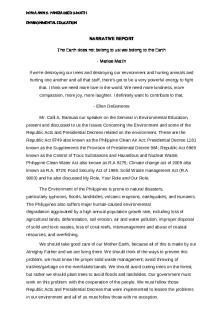Narrative Structure - Summary Film Studies PDF

| Title | Narrative Structure - Summary Film Studies |
|---|---|
| Course | Film |
| Institution | Kansas State University |
| Pages | 2 |
| File Size | 51.7 KB |
| File Type | |
| Total Downloads | 88 |
| Total Views | 151 |
Summary
Summary of Sikov narrative structure....
Description
Narrative Structure Narrative Structure Narrative: storytelling o Not all films are narrative: documentaries—non-fiction accounts of real people and events that may or may not tell a story in the process Avant-garde—experimental films that may be composed of nothing but shapes or colors or shots of ppl and things that are not assembled in the form of a tale Story and Plot Story: all the events of the narrative as they occur in chronological order from beginning to end, including not only those that we see and hear, but those we infer o Tells what happened from beginning to end Plot: the ordering and structuring of narrative events as they are presented in the film o Order the filmmaker reveals the story elements to the audience Diegesis: all the story elements presented by the narrative, no matter whether they are actually seen or heard onscreen or not Fabula: the story that each of us constructs as we watch and hear the syuzhet unfold Syuzhet: film’s plot; specific ordering of narrative elements within the film Scenes and Sequences Scene—defined by unity of time, space, and action o Unified action that takes place in one location during a single time period Sequence—maintains a unity of time, place or dramatic action but introduces a discontinuity o Defined by patterns of shots within each scene Flashback—a shot, sequence, or scene that takes place in the past, before the present-day time frame established by the film Flashforward—shot, sequence, or scene that takes place in the future, after the presentday time-frame established by the film Transitions from scene to scene Most scenes just cut Fade-in: image entirely black/white and new image gradually appears until full strength/clarity Fade-out: image gradually disappears until the screen is either all white or all black Iris-in: created when the image begins as a small circle in the middle of an all-white or all black screen and widens until it covers the screen Iris-out: full rectangular image shrinks in a circular form until it disappears in the middle of a screen Dissolve: one image fades out while a subsequent image fades in o Midway point is superimposition Wipe: one image appears to push another off the screen o May happen horizontally, vertically, diagonally, or take the form of a shape Crosscutting—editing that alternates two or more lines of action occurring in different places or times, thereby connecting them
Narrative Structure
o Cutting from one character in one space to another character un a different space then back to the first characters A-picture: feature that was more expensive to make (probably better known) B movie: lesser-known, probably cheaper made film
Character, desire, and conflict Desire: the central character’s pursuit of a goal Conflict: what gets in the way/prevents desire Analyzing conflict Segmentation—how to break down cinematic stories...
Similar Free PDFs

Apuntes film studies
- 12 Pages

Review questions film studies
- 4 Pages

Concussion film summary
- 1 Pages

Indigenous film summary
- 5 Pages

Annulment Summary and Structure
- 3 Pages

Structure - summary of toefl
- 72 Pages

Glory FILM Summary - Grade: B+
- 3 Pages

NARRATIVE REPORT
- 1 Pages
Popular Institutions
- Tinajero National High School - Annex
- Politeknik Caltex Riau
- Yokohama City University
- SGT University
- University of Al-Qadisiyah
- Divine Word College of Vigan
- Techniek College Rotterdam
- Universidade de Santiago
- Universiti Teknologi MARA Cawangan Johor Kampus Pasir Gudang
- Poltekkes Kemenkes Yogyakarta
- Baguio City National High School
- Colegio san marcos
- preparatoria uno
- Centro de Bachillerato Tecnológico Industrial y de Servicios No. 107
- Dalian Maritime University
- Quang Trung Secondary School
- Colegio Tecnológico en Informática
- Corporación Regional de Educación Superior
- Grupo CEDVA
- Dar Al Uloom University
- Centro de Estudios Preuniversitarios de la Universidad Nacional de Ingeniería
- 上智大学
- Aakash International School, Nuna Majara
- San Felipe Neri Catholic School
- Kang Chiao International School - New Taipei City
- Misamis Occidental National High School
- Institución Educativa Escuela Normal Juan Ladrilleros
- Kolehiyo ng Pantukan
- Batanes State College
- Instituto Continental
- Sekolah Menengah Kejuruan Kesehatan Kaltara (Tarakan)
- Colegio de La Inmaculada Concepcion - Cebu







